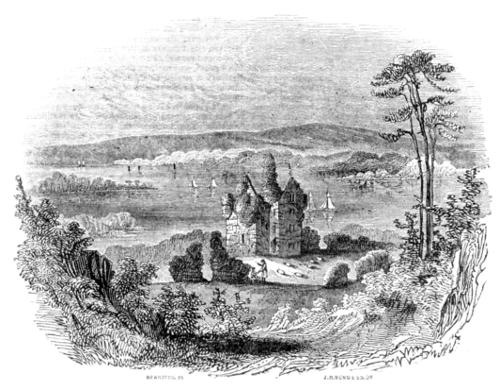THE IRISH PENNY JOURNAL.
| Number 23. | SATURDAY, DECEMBER 5, 1840. | Volume I. |

TULLY CASTLE, COUNTY OF FERMANAGH, LOOKING OVER LOUGH ERNE.
We have chosen the prefixed view of the Castle of Tully as asubject for illustration, less from any remarkable picturesquenessof character or historical interest connected with thecastle itself, than for the opportunity which is thus affordedus of making a few remarks on the beautiful lake—the Windermereof Ireland, as Mr Inglis happily called it—on thebank of which it is situated. We cannot conceive any circumstancethat better illustrates the truth of the general principlethat, as Shakspeare expresses it, “what we have weprize not at its worth,” than the fact that Lough Erne—theadmiration and delight of strangers, the most extensive andbeautifully diversified sheet of water in Ireland—is scarcelyknown as an object of interest and beauty to the people ofIreland generally, and is rarely or never visited by them forpleasure. It is true that the nobility and gentry who resideupon its shores or in their vicinity, are not deficient in a feelingof pride in their charming locality, and even boast its superiorityof beauty to the far-famed Lakes of Killarney; yettill very recently this admiration was almost exclusively confinedto themselves, and the beauties of Lough Erne were aslittle known to the people of Ireland generally as those of thelakes and highlands of Connemara, neither of which have everyet been included in the books concocted for the use of pleasuretourists in Ireland.
But Lough Erne will not be thus neglected or unappreciatedmuch longer. Its beauties have been discovered andbeen eulogised by strangers, who have taught us to set a justervalue on the landscape beauties which Providence has sobountifully given to our country; and it will soon be a reproachto us to be unfamiliar with them.
It would be utterly impossible, within the limits necessarilyassigned to our topographical articles, to give any detailedaccount of a lake so extensive as Lough Erne, and whose attractivefeatures are so numerous; but as these features shallfrom time to time be included among our subjects for illustration,it will be proper at least to give our readers a generalidea of its extent, and the pervading character of its scenery,on this our first introduction of it to their notice; and withthis view we shall commence with a description given of it byan author of a History of the County of Fermanagh, writtenin the seventeenth century, but not hitherto published.
“This lake is plentifully stocked with salmon, pike, bream,eel, trout, &c.
Seven miles broad in the broadest part. Said to contain[Pg 178]365 islands, the land of which is excellent. The largest of theislands is Inismore, containing nine tates and a half of oldplantation measure. Bally-Mac-Manus, now called Bell-isle,containing two large tates much improved by Sir Ralph Gore;Killygowan, Innis Granny, Blath-Ennis, Ennis-Liag, EnnisM’Knock, Cluan-Ennis, Ennis-keen, Ennis-M’Saint, andBabha.
These are the [islands] most notable, except the island ofDevenish, of which I’ll speak in its proper place; however, bythe bye, in Devenish is remembered the pious St Molaishe,who herein consecrated two churches and a large aspiringsteeple [the round tower], and an abbey, which abbey wasrebuilt ...